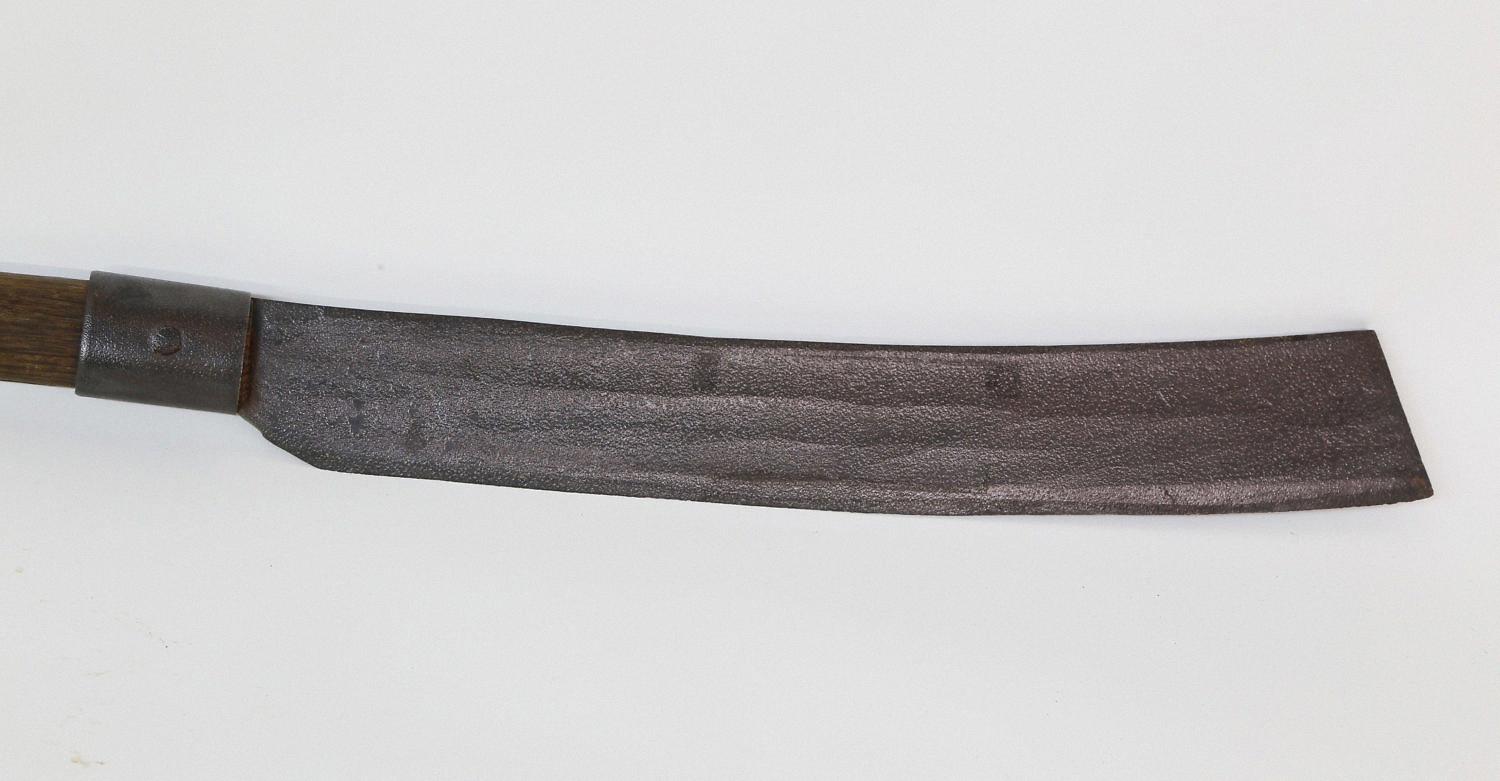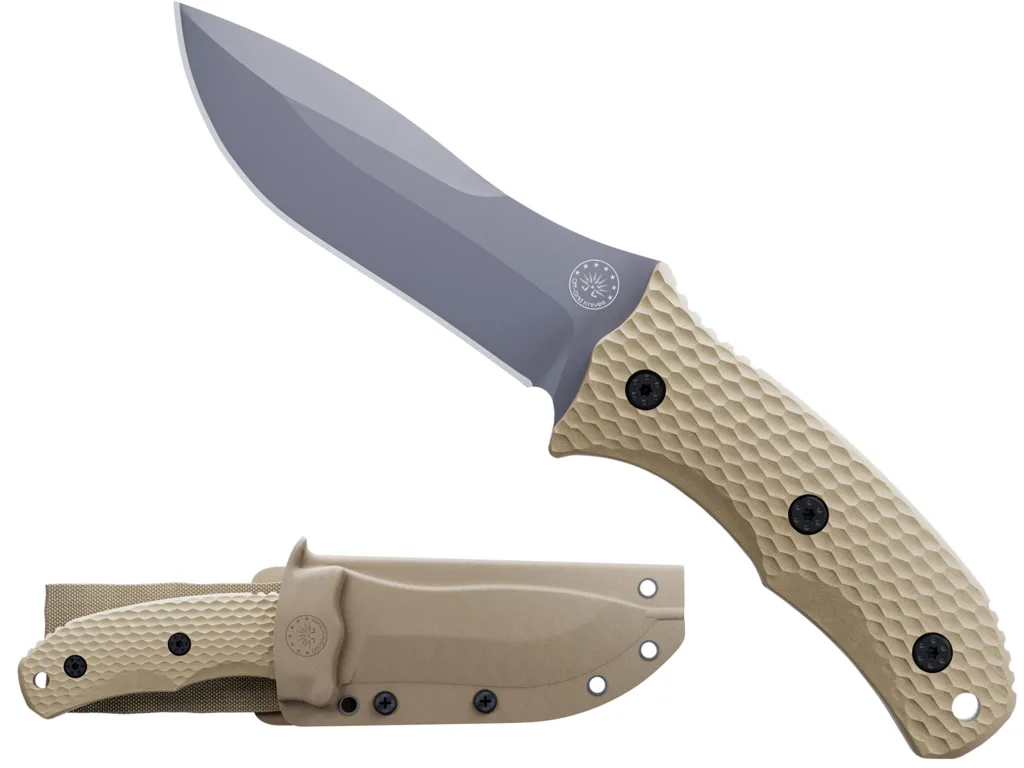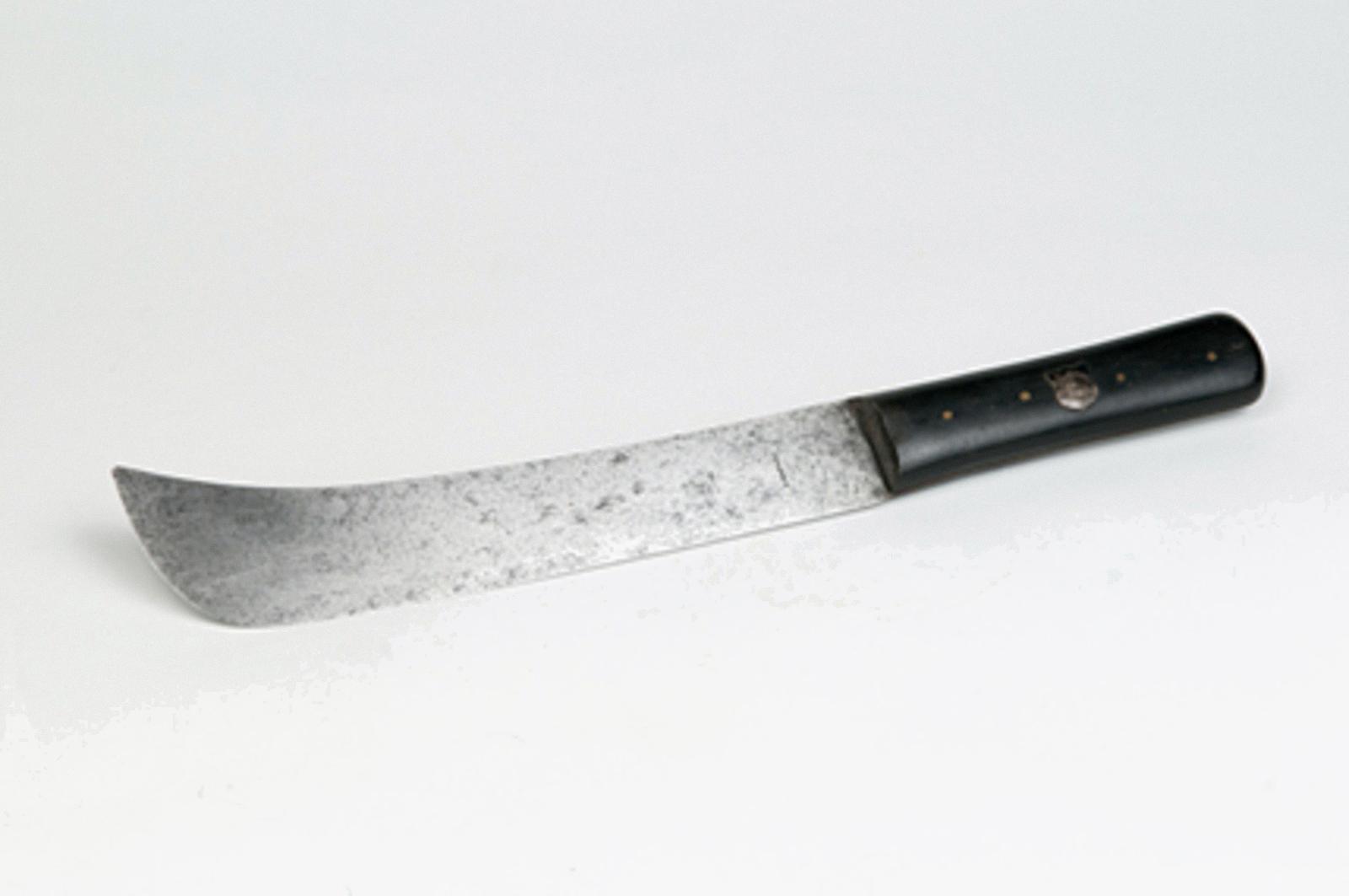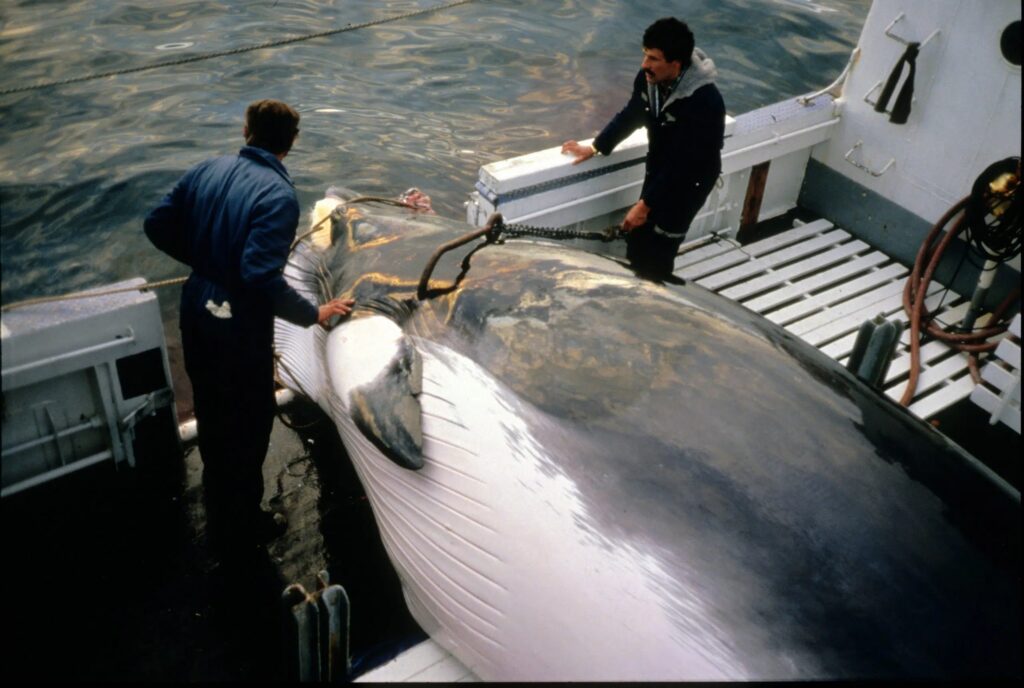Whaling was once a profitable and important trade that brought whale oil, a valuable source of fuel and light, to the world. Whalers were skilled and hardworking individuals who faced many risks and dangers whie out at sea. One of the essential tools in the whaling trade was the flensing knife.
A flensing knife, also known as a mincing knife or a whale knife, was used to remove the outer layer of blubber from a whale carcass. This was a crucial step in the process of obtaining whale oil. The knife was designed to be long and sharp, with a curved and pointed blade that allowed for precise cuts.
The process of flensing a whale was not an easy one. After a whale was killed, it was towed back to the ship where a platform called the ‘cutting stage’ was hung over its body. The captain and mate would then strip the blubber from the whale’s body using flensing knives. This process required great skill and strength, as the blubber was thick and heavy.
The crew would use the flensing knife to cut the blubber strips into thin slices down to, but not through, the thick whale skin. This process increased the surface area of the blubber and helped it melt faster in the try-pots. The try-pots were large cast iron kettles used to boil the blubber down into oil.
The flensing knife was also used to remove the whale’s skin, which was boiled down to make whale leather. The bones, or baleen, of the whale were also valuable and used to make a variety of products, such as corsets, umbrella ribs, and fishing rods.
The use of flensing knives was not only essential to the whaling trade, but it was also a dangerous task. The knives were sharp and heavy, and accidents were not uncommon. In addition, the smell of the blubber and blood was overwhelming, and the work was physically demanding.
The flensing knife played a crucial role in the whaling trade. It was a tool that required great skill and strength to use, and it was an essential part of the process of obtaining whale oil. While the whaling trade is no longer practiced, the flensing knife remains an important artifact of a bygone era.
Uses of a Flensing Knife
A flensing knife is a specialized tool used in the whaling trade to remove the outer layer of blubber from a whale carcass. This process is known as flensing, hence the name of the knife. The blade of the flensing knife is typically long and curved, with a sharp edge that is capable of cutting trough tough whale blubber and connective tissue. The handle of the knife is often made of wood or bone, with a curved shape that allows for a comfortable grip and precise control during the flensing process. the flensing knife is an essential tool for whalers, as it enables them to efficiently harvest the valuable blubber and other resources from a whale carcass.

Source: rafaelosonaauction.com
The Process of Whales Flensing
Flensing is the process of removing the blubber (the fatty, outer layer of skin) from a whale’s body. This process is typically carried out by experienced whalers, who use specialized tools to carefully cut away the blubber in large, even strips. To begin the process, the whale is towed back to the whaling ship and secured to the side of the vessel. A platform called the “cutting stage” is then hung over the whale’s body, providing a stable surface for the flensing process. The flensers typically work in pairs, usig long knives called flensing knives to carefully cut away the blubber in large, even strips. These strips are then hoisted up onto the deck of the ship using winches and pulleys, where they are further processed into oil and other products. Flensing can be a dangerous and physically demanding process, and requires a great deal of skill and experience to carry out safely and effectively.
The Benefits of Using a Blubber Cutter
A blubber cutter is a specialized knife used in the process of whaling. It is designed to cut blubber, which is the thick layer of fat beneath the skin of whales. The blubber cutter is typically a long, curved knife with a sharp edge. Whaling crews would use these knives to slice the blubber into thin strips, making sure not to cut trough the thick whale skin. This process increased the surface area of the blubber and helped it melt faster in the try-pots, which were large cauldrons used to render the blubber into oil. Blubber cutters were an essential tool for whaling crews, allowing them to efficiently harvest and process the valuable blubber from the massive bodies of whales.
Processing of Whales
Whales were traditionally processed by firt harpooning them with a heavy rope attached. Once the whale was killed, it would be towed to the ship and tied alongside. The next step was to begin the “cutting in” process, which involved peeling off the whale’s skin and blubber in long strips. These strips would then be boiled down to make whale oil, which was a valuable commodity in many industries. The process of cutting in was a grisly one, and it required a great deal of skill and strength to complete. Despite the unpleasant nature of the process, it was an important part of many cultures and economies throughout history.

The Definition of a Coyote Knife
A coyote knife is a type of hunting knife that is designed for use in the great outdoors. It is typically made from high-quality materials such as Damascus steel, which is known for its ability to hold a sharp edge and resist rust and corrosion. The blade of a coyote knife is usually full flat-ground, which means that it has a flat surface that runs from the spine of the blade all the way down to the edge. This design alows for maximum cutting efficiency and precision. Additionally, coyote knives often feature steel bolsters and a red mosaic handle pin, as well as a brass lanyard tube for attaching a lanyard or other accessory. The handle of a coyote knife is typically made from a beautiful and durable material such as rosewood, which adds to its overall elegance and functionality. a coyote knife typically comes with a brown leather sheath for safe and easy carrying.
Can a Whale Cause Eardrum Damage?
A whale can potentially pop your eardrums with its loud vocalizations. Sperm whales, in particular, are known for producing intense and powerful clicking sounds that can reach up to 236 decibels. This is considered to be the loudest sound produced by any animal on earth.
If a person were to be in close proximity to a vocalizing sperm whale, the sound waves from the clicks could be strong enough to rupture their eardrums. However, it is highly unlikly that a human would ever be in a situation where they would be close enough to a vocalizing whale to experience this kind of damage.
It is important to note that whales do not intentionally produce sounds that could harm humans or other animals. Their vocalizations are a natural part of their communication and echolocation abilities, and they play a vital role in the whale’s survival and social interactions.
Do Whales Cry Tears?
Whales are known for their immense size and their fascinating behaviors, but can these gentle giants cry tears? The answer to this question is somewhat complex. While whales do have tear glands, they do not have the tear ducts necessary for crying in the way that humans do. The tear glands in whales are used to secrete a greasy liquid that helps to keep their eyes clean and free from debris. This liquid also helps to protect the surface of the eye from saltwater and other irritants, which is particuarly important for whales that spend most of their time in the ocean. So while whales do have the ability to produce tears, they do not cry in the way that humans are familiar with. Instead, they use their tear glands to maintain healthy eyes and protect them from the harsh ocean environment.
Exploring the Reasons Behind Humpback Whale Fin Slapping
Humpback whales are known for their impressive displays of breaching, tail slapping, and fin slapping. When it comes to fin slapping, humpbacks will often roll onto their side or back and slowly slap the water’s surface with one fin or both fins simultaneously. While the exact reason for this behavior is not fully understood, it is believed that the slapping of fins may serve as a communication signal to other whales. These signals may be used to attract potential mates, establish dominance, or communicate a change in direction when traveling in a group. Additionally, the loud sound created by the fin slapping may also help to stun or disorientate prey, making it easier for the whales to catch and consume their food. while the exact reason for fin slapping remains a topic of ongoing research, it is clear that this behavior plays an important role in humpback whale communication and hunting strategies.

Source: dhtcollections.com
What is the Name of an Eskimo Skinning Knife?
An Eskimo skinning knife is commonly known as an ulu. It is a traditional multi-purpose cutting tool used by the Inuit people, primarily by women for tasks such as skinning and cleaning animals, preparing fish, and cutting up other materials like fabric or leather. The blade of an ulu is semi-circular in shape and attached to a handle, which can be made of a variety of materials including wood, bone, or antler. The ulu has been an important part of Inuit culture for thousands of years, and its design and use have been passed down throuh generations of Inuit women. Today, ulus are still used by many Inuit communities and are also popular among outdoor enthusiasts and chefs for their versatility and efficiency.
The Origin of the Term ‘Scrimshaw’
The term “Scrimshaw” is believed to have originated from an Old Dutch word “scrimshank” which means “a waste of time” or “idler”. The word was used to describe a person who spent too much time on non-essential activities. Sailors on whaling ships during the 19th century used to carve intricate designs and images on whale teeth, bone, and ivory during their idle time. These carvings were oten used as a form of entertainment, as well as a way to earn some extra money by selling them at ports. The sailors who created these carvings were referred to as “scrimshanders”, which eventually led to the term “scrimshaw” being used to describe their craft. Today, scrimshaw is a highly valued form of folk art that is collected and appreciated by people all over the world.
The Benefits of Using a Boxer Cutter
A box cutter is a specialized cutting tool that is primarily designed for opening cardboard boxes. It typically features a retractable razor blade that is housed in a thin metal or plastic sheath. The blade can be extended or retracted as needed, allowing the user to adjust the cutting depth and control the level of precision required for a particular task. Box cutters are commonly used in a variety of industries, including packaging, shipping, and retail, as well as in households for DIY projects or home repairs. These tools are lightweight and easy to use, making them an essential item for anyone who needs to open boxes or cut throuh other materials quickly and efficiently.
The Country with the Highest Number of Whale Deaths
Norway kills the most whales out of the three countries where commercial whale hunting continues, which includes Japan and Iceland. Despite a global ban on commercial whaling, Norway has continued hunting whales since 1993, with an annual quota of around 1,278 minke whales. While Iceland also engages in commercial whaling, they recently announced their decision to stop this practice by 2024. However, Norway remains the country with the highest number of whale kills, making it a significant contributor to the ongoing controversy surrounding commercial whaling.

What Does the Taste of Whales Resemble?
Whales are not like fish in terms of taste because they are mammals. Therefore, whale meat tastes more like a very gamey version of beef, or even venison. It is important to note that whale meat is more tender than beef and easier to digest, according to some people who have consumed it. whales do not taste like fish but rather have a unique flavor that is more similar to that of red meat.
Can Humans Swim Through the Arteries of a Whale?
The arteries of a blue whale are incredibly large, much larger than those of any oter animal on Earth. These arteries are responsible for pumping blood through the whale’s massive body and into its vital organs. However, despite their size, it is not possible for a human to swim through the arteries of a blue whale. While it is true that the arteries are large enough to accommodate a full-size human, the walls of the arteries are far too thick and dense for a human to pass through. Additionally, the pressure within the arteries is far too high for a human to survive. Therefore, while the arteries of a blue whale are indeed impressive in their size, they are not a suitable environment for human exploration.
Conclusion
The flensing knife played an essential role in the whaling industry. This specialized tool was used to remove the outer layer of blubber from whale carcasses, allowing the crew to collect and process the valuable oil. The process of flensing was a difficult and dangerous task, but it was necessary to make the most of the whale’s resources. The design of the flensing knife was carefully crafted to be effective in this task, with a sharp, curved blade that coud easily slice through the thick layer of blubber. Today, the use of flensing knives is no longer necessary, as the whaling industry has drastically declined due to conservation efforts. However, the history of the flensing knife remains an important reminder of the impact of human activities on the natural world.
